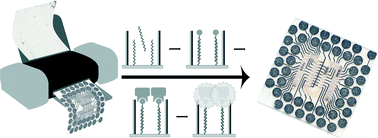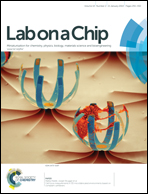Chip-on-foil devices for DNA analysis based on inkjet-printed silver electrodes†
Abstract
For a rapid on-site diagnosis of pathogens, low-cost chip-based devices are of great interest. Here, we report the successful fabrication of inkjet printed silver electrodes on polymer foils as disposable chips for molecular DNA analytics. In order to manufacture these electrode structures, silver nanoparticle inks were inkjet printed onto planar polypropylene substrates. Due to the low thermal stability of the foils, substrate preserving sintering techniques, including low temperature thermal sintering and low pressure argon plasma sintering, were implemented. Thus, sufficient electrical conductance of the printed structures at processing temperatures ≤100 °C was achieved. To test the applicability of the manufactured chips, specific capture DNA was immobilized within the gaps of the conductive electrode paths and hybridized in the next step with biotin-labeled target DNA. Subsequently, an enzymatically generated silver nanoparticle deposition was induced that bridges the electrode gap. This enabled both conductance measurement and gray value analysis as a fast, simple and robust electrical and optical read-out system. The proof-of-principle experiments successfully demonstrated the applicability of these convenient chip-on-foil devices for nucleic acid based pathogen detection.


 Please wait while we load your content...
Please wait while we load your content...